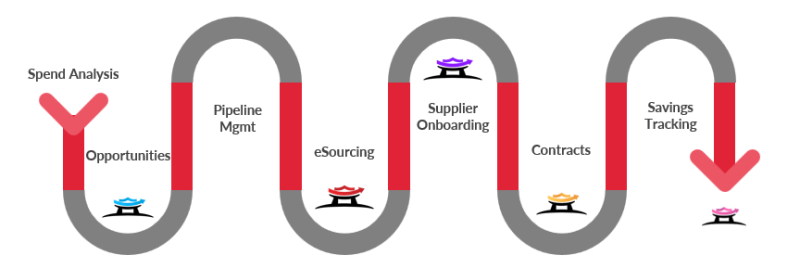Title
Procurement: A Comprehensive Guide for Building an Effective Process

Procurement is crucial in the supply chain process. It’s more than finding the most cost-effective suppliers or seeking positive supplier reviews. In large supply chains, it often represents a significant portion of the total spend and should be managed effectively to achieve maximum value.
In this blog, we’ll delve into all this procurement: what it is, why it is an important business function and how the three main components come into play — People, Process, and Technology.
Defining procurement
Procurement is the process of sourcing or acquiring services or goods for a company. Some companies use the term procurement only to refer to the actual purchasing of goods and services while others denote the process leading up to the acquisition as procurement. Procurement involves two entities: the purchaser and the seller. The purchaser is usually a company that procures goods or services to make its own final product. That’s why it’s crucial for the purchaser to find the best quality of goods or services at the most competitive rates.

Procurement looks like a simple process at first glance. However, it involves several activities:
- Vendor selection
- Payment negotiation
- Strategic screening
- Final selection
- Contract Arbitration
- Final purchase
- Supply management
Types of procurement
Procurement can be divided into two main types:
Direct procurement: Direct procurement refers to purchasing the input (raw material, for example) that a company needs to produce its end product. The input cost and efficiency of direct procurement impact the business’s profitability and performance. When there’s an obstacle in the direct procurement process, it impacts the corporation’s ability to manufacture its product.
Indirect procurement: Indirect procurement refers to procuring the service or input that isn’t directly used in producing the company’s product but is vital for their everyday operations. Indirect procurement can include office provisions or upkeep services for the equipment used for manufacturing. Obstacles in this type of procurement process impact the operations of the company.
Components of procurement
In the age of digitization, procurement rests on three components that support the organization’s business objectives, improve profitability, and also generate long-term sustainable value. These components are:
1. People
The number of people involved in the procurement process depends on the scale and value of the procurement orders. For instance, most small companies have only a few procurement personnel.
Procurement used to be considered a back-office task and an obstruction to the expenditure wish lists of in-house departments, but things are changing today within many businesses.
Thanks to digital transformation, procurement has entered the spotlight. Now, many procurement frontrunners use a range of strategic hard skills and tactical soft skills. Along with project management and negotiation skills, there are other skills equally important such as active listening, conflict management and compassion.
2. Process
The procurement process can only function efficiently when it’s well-designed and systematized. A disordered procurement process can result in inefficiencies and discrepancies that can lead to delays and difficulties with the purchases as well as the payments, affecting the final product.
Every organization implements a process that is exclusive to the business, and transparency is crucial in every stage of the process. Procurement can generally be divided into two categories: upstream and downstream.
Upstream Procurement Process: Upstream procurement includes everything that occurs from defining the requirements, to sourcing and granting the contract. For example, issuing a request for proposals when you identify a business need and are holding eAuctions to negotiate pricing from qualified bidders.
Downstream procurement process: Downstream procurement involves everything that occurs after the contract is granted. Activities in the upstream process have the most substantial influence on the downstream results, such as contract management.
3. Technology
It’s not possible to write off the impact of digital transformation on procurement any longer. Not only has it streamlined processes, but it has also made work more enjoyable. For instance, source-to-contract technology helps you optimize the upstream procurement process so you can save hours or even days of work.
No more manually managing suppliers and updating spreadsheets or viewing spend analytics by creating intricate pivot tables. Instead, you can maintain all this info in a centralized, cloud-based repository.
Digital transformation has made information easily accessible to all stakeholders. Now, you can seamlessly automate workflows, create contract templates and ensure that all proposals maintain consistency and compliance.
Technology has amplified visibility in the supply chain, helping teams better manage risk and ensure savings throughout the entire source-to-contract process. It reduces errors, eliminates redundancies and streamlines communication.
Consequently, businesses experience shorter cycle times for every sourcing event.
The benefits of eProcurement
eProcurement is the acquisition and sale of supplies, equipment and services via a centralized web interface or another networked system. This technology helps to consolidate and automate interactions between a company and allows other value chain partners to increase the speed and efficiency of procurement activities.

Streamline your procurement with Market Dojo
Market Dojo offers a full suite of upstream eProcurement solutions that can help organizations like yours fully enhance your procurement strategy. All our tools are designed by procurement specialists and developed to help teams, irrespective of budgets or experience.
Even if you’re not well-versed in digital procurement and online supplier management, our innovative procurement tools are built from the ground up to make your life easier. Our systems are personalized to help you meet a range of different essential procurement goals.
Market Dojo’s on-demand business model offers procurement teams the flexibility to use our tools as and when they require them — without any long-term contract obligations. Get in touch now.
Subscribe to new posts
